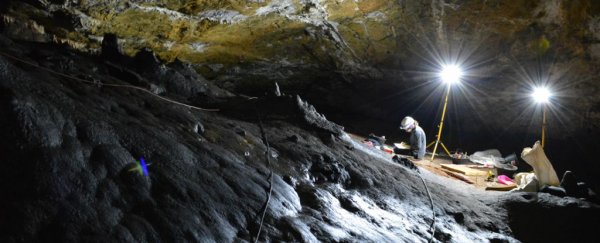If archaeology has shown us anything, it's the sobering impermanence of our lives.
Human settlements come and go. We may remain in specific regions, but the cladding on that region changes, the past often buried in ruins hidden beneath our feet. But one place seems to have been so special that humans used it, if somewhat sporadically, for 50,000 years.
That place is Cueva de Ardales, a cave in Málaga in southern Spain, famed for the extensive prehistoric art daubed and inscribed on its walls. Over 1,000 such works have been cataloged, some of which famously and controversially demonstrated that Neanderthals could create art.
Now the first excavations have been performed in the cave, finally giving scientists a better idea of what ancient Neanderthals and modern humans used the cave for – and the length of time for which they used it.
Over the course of 50,000 years, from the time Neanderthals started using the cave 65,000 years ago, Neanderthals and modern humans used Cueva de Ardales for the purposes of making art and burying their dead, and very little else.
"Our research presents a well-stratified series of more than 50 radiometric dates in Cueva de Ardales that confirm the antiquity of Paleolithic art from over 58,000 years ago," explains a team of researchers, led by archaeologist José Ramos-Muñoz from the University of Cadiz in Spain.
"It also confirms that the cave was a place of special activities linked to art, as numerous fragments of ochre were discovered in the Middle Paleolithic levels."
The excavations took place between 2011 and 2018, focusing on the cave's entrance. This is likely to be the most highly-trafficked region of the cave, and contains the largest concentration of non-figurative, abstract paintings.
From here, the researchers dug down to access the different layers, buried over time, that contain traces of human presence.
These layers revealed the patchy occupation history of the cave, starting from the bottommost, earliest layer. This was dated to over 58,000 years ago using radiocarbon dating, consistent with previously obtained dates for the oldest paintings in the cave, abstract works consisting of dots, fingertip daubs and hands. This was the Neanderthal occupation of the cave, ceasing around 43,000 years ago.
Modern humans seem to have arrived in the region around 35,000 years ago, suggesting that the cave was unused for quite some time, around 7,000 years. From the time that modern humans arrived, the cave was used on and off until about the beginning of the Chalcolithic, or Copper Age, towards the end of the Neolithic.
Interestingly, even though they arrived much later, modern humans seem to have used the cave for similar purposes to the Neanderthals. None of the artifacts recovered from any period were related to domestic tasks, suggesting that the cave was not used as a living space.
Instead, the team found lumps of ochre, used for painting and sometimes as a ritual material throughout prehistory, as well as shells and animal teeth that had been drilled, perhaps to be used as jewelry.
They also found human remains, suggesting that the cave was used by modern humans to inter the dead during the early Neolithic.
"The traces of human activity are ephemeral and point out to very specific activities related to the symbolic use of the cave," the researchers write in their paper.
"During the Palaeolithic, the cave was certainly used for the production of rock art, which is attested by the presence of more than 1,000 motifs and the presence of a number of potential lumps of ochre in the excavated context. This non-domestic use of the cave continues later in the Neolithic and Chalcolithic, when the cave was used as burial place."
The results appear to confirm that the cave was highly symbolically important for a long period throughout prehistory, marking it as a significant and valuable archaeological site for studying human history in Europe.
The research has been published in PLOS ONE.
